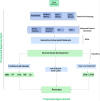Enhanced EEG signal classification in brain computer interfaces using hybrid deep learning models
- PMID: 40715225
- PMCID: PMC12297340
- DOI: 10.1038/s41598-025-07427-2
Enhanced EEG signal classification in brain computer interfaces using hybrid deep learning models
Abstract
Brain-computer interfaces (BCIs) establish a communication pathway between the human brain and external devices by decoding neural signals. This study focuses on enhancing the classification of Motor Imagery (MI) within BCI systems by leveraging advanced machine learning and deep learning techniques. The accurate classification of electroencephalogram (EEG) data is crucial for enhancing BCI performance. The BCI architecture processes electroencephalography signals through three critical stages: data pre-processing, feature extraction, and classification. The research evaluates the performance of five traditional machine learning classifiers- K-Nearest Neighbors (KNN), Support Vector Classifier (SVC), Logistic Regression (LR), Random Forest (RF), and Naive Bayes (NB)-using the "PhysioNet EEG Motor Movement/Imagery Dataset". This dataset encompasses EEG data from various motor tasks, including both actual and imagined movements. Among the traditional classifiers, Random Forest achieved the highest accuracy of 91%, underscoring its efficacy in motor imagery classification within BCI systems. In addition to conventional approaches, the study also explores deep learning techniques, with Convolutional Neural Networks (CNN) and Long Short-Term Memory (LSTM) networks yielding accuracies of 88.18% and 16.13%, respectively. However, the proposed hybrid model, which synergistically combines CNN and LSTM, significantly surpasses both traditional machine learning and individual deep learning methods, achieving an exceptional accuracy of 96.06%. This substantial improvement highlights the potential of hybrid deep learning models to advance the state of the art in BCI systems, offering a more robust and precise approach to motor imagery classification.
Keywords: BCI; Classification; Deep learning; Disabilities; EEG; GAN’s; Machine learning; Motor imagery; Riemannian geometry.
© 2025. The Author(s).
Conflict of interest statement
Declarations. Dataset description: This dataset consists of over 1,500 one- and two-minute EEG recordings from 109 volunteers, recorded using the BCI2000 system across 64 channels sampled at 160 Hz. Subjects performed motor and imagery tasks, including hand and foot movements, while EEG signals were captured. The recordings are provided in EDF + format, accompanied by annotation files indicating task events. For further details on the dataset, please refer to the repository link provided above. Competing interests: The authors declare no competing interests.
Figures













Similar articles
-
Toward calibration-free motor imagery brain-computer interfaces: a VGG-based convolutional neural network and WGAN approach.J Neural Eng. 2024 Jul 31;21(4). doi: 10.1088/1741-2552/ad6598. J Neural Eng. 2024. PMID: 39029497
-
Enhanced Online Continuous Brain-Control by Deep Learning-Based EEG Decoding.IEEE Trans Neural Syst Rehabil Eng. 2025;33:2834-2846. doi: 10.1109/TNSRE.2025.3591254. IEEE Trans Neural Syst Rehabil Eng. 2025. PMID: 40690341
-
Artificial intelligence based BCI using SSVEP signals with single channel EEG.Technol Health Care. 2025 Jul;33(4):1905-1916. doi: 10.1177/09287329241302740. Epub 2025 Feb 5. Technol Health Care. 2025. PMID: 39973870
-
Enhancing motor imagery EEG signal decoding through machine learning: A systematic review of recent progress.Comput Biol Med. 2025 Feb;185:109534. doi: 10.1016/j.compbiomed.2024.109534. Epub 2024 Dec 12. Comput Biol Med. 2025. PMID: 39672015
-
Systematic Review of EEG-Based Imagined Speech Classification Methods.Sensors (Basel). 2024 Dec 21;24(24):8168. doi: 10.3390/s24248168. Sensors (Basel). 2024. PMID: 39771903 Free PMC article.
References
-
- UNDRR. 2023 global survey report on persons with disabilities and disasters. UNDRR (2023).
-
- National Institute of Neurological Disorders and Stroke. Amyotrophic lateral sclerosis (als). National Institute of Neurological Disorders and Stroke (n.d.).
-
- Tang, X., Zhang, N., Zhou, J. & Liu, Q. Hidden-layer visible deep stacking network optimized by Pso for motor imagery Eeg recognition. Neurocomputing234, 1–10 (2016).
MeSH terms
Grants and funding
- No.RS-2022-00155857/Institute of Information & communications Technology Planning & Evaluation (IITP) grant funded by the Korea government (MSIT) (No.RS-2022-00155857, Artificial Intelligence Convergence Innovation Human Resources Development (Chungnam National University). Also supported part by Woosong university research fund 2024.
- No.RS-2022-00155857/Institute of Information & communications Technology Planning & Evaluation (IITP) grant funded by the Korea government (MSIT) (No.RS-2022-00155857, Artificial Intelligence Convergence Innovation Human Resources Development (Chungnam National University). Also supported part by Woosong university research fund 2024.
LinkOut - more resources
Full Text Sources

